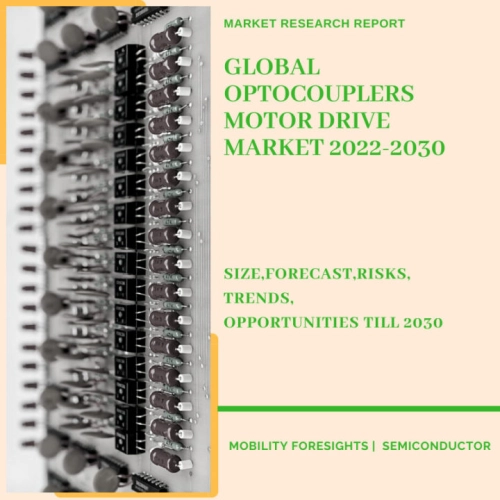
- Get in Touch with Us

Last Updated: Apr 25, 2025 | Study Period: 2022-2030
The Optocoupler is an electrical component that can be used in a variety of applications to connect high-power electronic devices to low-voltage digital or control circuits.

It is common practice to use optocouplers or opto isolators to transmit data between two components of a circuit that operate at drastically different voltage levels. These devices combine an infrared LED (also known as an IRED or ILED) with an infrared sensitive device, such as a photo diode or a photo transistor.
The Global Optocouplers Motor Drive market accounted for $XX Billion in 2021 and is anticipated to reach $XX Billion by 2030, registering a CAGR of XX% from 2022 to 2030.
Development of LTCC-packaged optocouplers as optical galvanic isolation for high-temperature applications.The high-temperature optocoupler package was created using low temperature co-fired ceramic (LTCC) technology. The best driving characteristics, coupling behaviours, and reaction times of the optocouplers were focused on and examined.
To get the best coupling behaviours, emitters and detectors should have varied emission and spectral wavelengths. With emitters and detectors of emission and spectral wavelength in the red spectrum (i.e., 620-750 nm), relatively high coupling efficiency is attained, leading to larger current transfer ratios (CTR).
Optocouplers with numerous detectors running in parallel were created in order to further improve the electrical performance. Temperatures between 25 and 250 °C were used to characterise the optocouplers' CTR, leakage current, and response speed (i.e., propagation delay, rise time, and fall time).
While the leakage current and response speed exhibit no change with temperature, the CTR deteriorates at high temperatures. Additionally, models and analyses are done to examine how optocouplers behave at various temperatures.
| Sl no | Topic |
| 1 | Market Segmentation |
| 2 | Scope of the report |
| 3 | Abbreviations |
| 4 | Research Methodology |
| 5 | Executive Summary |
| 6 | Introduction |
| 7 | Insights from Industry stakeholders |
| 8 | Cost breakdown of Product by sub-components and average profit margin |
| 9 | Disruptive innovation in the Industry |
| 10 | Technology trends in the Industry |
| 11 | Consumer trends in the industry |
| 12 | Recent Production Milestones |
| 13 | Component Manufacturing in US, EU and China |
| 14 | COVID-19 impact on overall market |
| 15 | COVID-19 impact on Production of components |
| 16 | COVID-19 impact on Point of sale |
| 17 | Market Segmentation, Dynamics and Forecast by Geography, 2022-2030 |
| 18 | Market Segmentation, Dynamics and Forecast by Product Type, 2022-2030 |
| 19 | Market Segmentation, Dynamics and Forecast by Application, 2022-2030 |
| 20 | Market Segmentation, Dynamics and Forecast by End use, 2022-2030 |
| 21 | Product installation rate by OEM, 2022 |
| 22 | Incline/Decline in Average B-2-B selling price in past 5 years |
| 23 | Competition from substitute products |
| 24 | Gross margin and average profitability of suppliers |
| 25 | New product development in past 12 months |
| 26 | M&A in past 12 months |
| 27 | Growth strategy of leading players |
| 28 | Market share of vendors, 2022 |
| 29 | Company Profiles |
| 30 | Unmet needs and opportunity for new suppliers |
| 31 | Conclusion |
| 32 | Appendix |